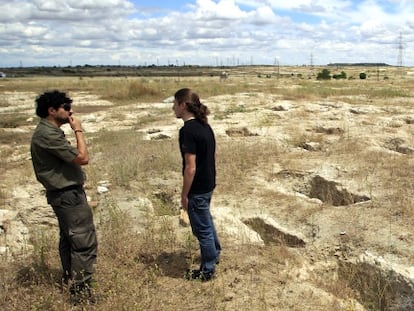Just a pile of stones, or a priceless window onto the past?
A Paleolithic flint quarry has been discovered at a housing development in Madrid The find has raised the question of how best to preserve historical sites such as these
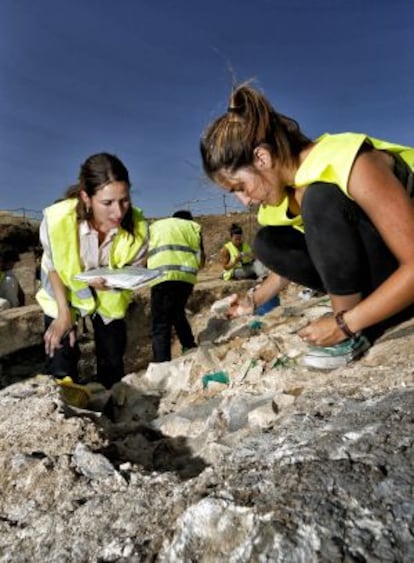
It's a meticulous process: slow and labor intensive. The archeologist's tiny brush cleans away another microscopically thin layer of dirt to uncover a sliver of flint, and then marks the spot with a small red drawing pin. Between 200,000 to 300,000 years ago, another hand may well have uncovered this same piece of flint and tapped gently away at it, slowly creating an axe blade able to fell the mammoths that roamed the wetlands around the Jarama and Manzanares rivers in the southeast of the Madrid region, in what today is the dormitory town of Vicálvaro.
Under a searing sun, around half-a-dozen archeologists are brushing patiently away at a 50-square-meter patch of parched gray earth in what seems like the middle of nowhere. They are gradually uncovering what they believe is a flint quarry from the Late Paleolithic era that they have named Charco Hondo (Deep Pond).
This is just one of more than 3,000 archeological sites in Madrid, of which 18 have now been designated museums. But as Sergio Bárez, the geo-archeologist who is co-running the excavation, nothing of the size and quality of this site has been found so far.
The problem now is what to do with it.
Local residents' associations and the Socialist Party want it developed and opened to the public, while some experts say that it should be left largely unexcavated until a later date. This is a very special site, says Bárez: "It is extremely well preserved, like a moment frozen in time."
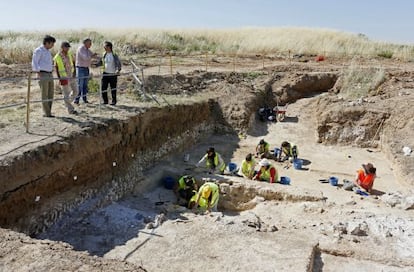
Charco Hondo was first discovered six years ago, but work only began in early June. There is no great hurry. The collapse of the property market and a Supreme Court ruling has delayed plans to build 15,400 homes here.
Investigators uncovered the site after noticing a dip in the terrain. They dug down a few meters, and soon came across discarded flint that had obviously been worked by hand. The site is traversed by dozens of small gullies that have eroded the soil to expose the flints. The same gullies then washed sand and silt over the flints, protecting them through the centuries. "This is how primitive man found raw materials," says Bárez, adding that he and his colleagues are carrying out further research to establish whether the site was developed by Neanderthals or their predecessors, Homo heidelbergensis.
Close by, Bárez and his team have found remains from other periods, such as Casa Montero, which dates back to the Neolithic period, and El Cañaveral, where four sites from the Mid-Paleolithic era have been uncovered dating back between 50,000 and 100,000 years. Two years ago, while working on a new housing development called Los Ahijones, construction workers came across a Visigoth necropolis with 824 tombs and the remains of 1,500 individuals dating back to the sixth and seventh centuries of the modern era, much of which has since been removed and put on show in nearby Alcalá de Henares.
Varied heritage
Madrid's heritage department began working on its plan to decide which archeological sites to open to the general public in 2003. There are currently 18 that can now be visited, with another 15 planned. Among those now open is the prehistoric site at the Carpetana subway station, in the southwest of the capital, which includes examples of animal and plant life from the Miocene era, between 23 and five million years ago. In Colmenar del Arroyo, 60 kilometers northwest of Madrid, a Civil War bunker has been restored and opened to the public. And a medieval necropolis at Sieteiglesias, in the north of the region, can now be visited. Some 85 tombs have been excavated, some dug into rock, and others built of complex stone layers.
The heritage department of the Popular Party-controlled Madrid regional government plans to carefully cover Charco Hondo with a special material and then layer sand on top after transferring the finds there to Madrid's Autónoma University for further examination, after which the artifacts will be exhibited.
Covering the site, instead of opening it as an open-air museum, "is not about money," says Ignacio Muñoz, the director general of Madrid's heritage department. "This place is of great scientific interest, but has no visual appeal," he argues. "It is like a quarry - the people who lived here came to chip stone away, and then they left. Most visitors would see little, unless they had an archeologist with them to explain things."
The regional government has cut spending on archeological investigation over the last two years, from around 500,000 euros in 2011 to 420,000 euros for this year.
With little in the way of tourist attractions, for Vicálvaro, this latest archeological discovery could be one way to attract more visitors, say both the United Left and Socialist Party, who have already campaigned to develop the necropolis as an open-air museum. Archeologists are exploring nearby, where they believe they have uncovered the remains of a small community from the same period. They want the regional government to put money into developing the sites.
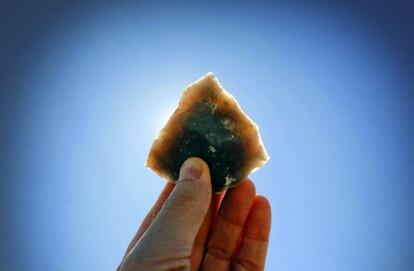
The development of the 630-hectare site of the Visigothic necropolis uncovered during construction work at Los Ahijones offers a model for how Charco Hondo could be managed. In the case of Los Ahijones, a solution was reached that satisfied the property developer, the owner of the land, local government, and archeologists and historians. But the process can be difficult.
"In other similar situations we have often had to fight hard to convince land owners, because they're the ones who stand to lose financially," says Ignacio Muñoz of Madrid's heritage department. A compensation board set up by the developers of Los Ahijones has already spent three million euros on studies, surveys and excavations, some 900,000 euros of which has been spent on the Visigothic necropolis itself.
Jorge Vega, an archeologist who works for Argea, a company that specializes in carrying out surveys for construction companies that come across sites of historic interest, says that it can often be hard to find consensus. "Normally, building companies are focused on their project and insist that any find is of little value," he says.
It has taken more than 30 years of research and excavations to complete the eight-hectare site at Complutum, a Roman villa at Alcalá de Henares, which opened to the public in 2009.
Building companies normally insist that archeological finds are of little value"
"The decision-making process is long and complicated," says Sebastián Rascón, the head of excavations at Complutum. "In reality, there is no standard procedure to decide whether to leave a site in situ, or to remove all the artifacts and put them in a museum. The villa at Alcalá de Henares was first discovered in the 16th century, and has suffered over the years. The entire site covers some 50 hectares, half of which is now filled with housing.
"Before deciding to turn the site into a museum, extensive research is needed because an archeological site will keep yielding new finds for many years," Rascón adds. He believes that it is always a good policy to leave part of any site unexcavated for future generations that will likely have more sophisticated methods for assessing what lies under the ground, and how best to remove it.
In the case of the Visigothic cemetery, the bones that have been found have allowed archeologists to learn more about the illnesses that ailed our ancestors, and even whether they suffered from kidney stones. But the regional government has rejected the idea of preserving the Visigothic site on the basis that there are 60 others like it in the region, all dating from the same period, and all more accessible than the Vicálvaro cemetery. Two of them have already been turned into museums.
Meanwhile, over at Charco Hondo, detailed examination of the tools used by man 200,000 years ago tells us a great deal about their level of development and early technology. "Our hypothesis is that these people moved around in small groups, each of which would have experts in tool making," says Javier Baena, a professor of Prehistory at the Autónoma University, as he chips away at a nodule of flint, sharpening it until it can cut paper.
People find it hard to imagine someone chipping away at a piece of stone"
The open-air flint quarry will be left as it is, but part of the contents of the site will likely be examined. The property developers who own the land say that they, and another company building on the nearby Los Berrocales development, are happy to work with the regional government's heritage department if it decides to build a museum tracing the history of the area from the Paleolithic era to the 16th century, taking in the late Roman period, the Middle Ages, the Islamic occupation and the early modern period.
Diana Díez, head of the archeology section of the Madrid College of Doctors and Graduates, says that scientists need to inform the general public about the importance of what they do. "We have not reached people in the way that we would have liked to," she says. "If we do not know about our heritage, how can we protect it?"
Díez says that Greece provides a model to follow: "If you go to Greece, you will see people walking miles and miles to see what people in this country would simply dismiss as a pile of stones."
Díez says that she understands that for most people, who have no training in archeology, it is hard to understand the importance of a 200,000-year-old flint quarry. A Visigothic cemetery is easier to relate to, she says, "but most people find it hard to imagine somebody chipping away at a piece of stone 300,000 years ago."
The key to an archeological site's survival depends on digging up something special, says Javier Baena: "If we were to find a bone, that would be different, or some kind of animal," he says, adding that this is what put Atapuerca, in northern Spain, where the earliest European hominid fossil remains, dating back 800,000 years, have been found. Atapuerca, which was occupied continuously until the early modern era, is now a UNESCO World Heritage Site attracting thousands of visitors each year.
Baena is hopeful that Charco Hondo will also yield something special. "Archeology is not an exact science," he says. And who knows, perhaps one morning the brush will remove a layer of earth, and instead of uncovering another flint, it will reveal the remains of a mammoth, slaughtered by razor-sharp flint axes.
A law for landowners
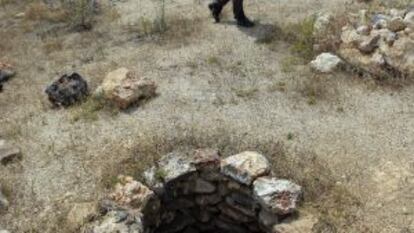
The Madrid government's new legislation on protecting the region's heritage was passed on June 19, 2013, despite fierce criticism from academics and archeologists, as well as the Socialist Party and United Left opposition. They say that the new law will put fewer restraints on property developers - notably the company that is to build the Eurovegas casino complex in the southeast of the city - who come across sites of historical interest. "The problem with this law is that it only protects what we already know exists, rather than what we suspect may exist, and archeology is about what we don't know is there but what we think might be there," says Diana Díez of Madrid's College of Doctors and Graduates.
Until now, property developers have been obliged by law to present plans on the likely environmental impact of their project, as well as contingencies in the event of uncovering an archeological site. Preliminary excavations would then be carried out, and if anything was found, the site would be uncovered and a quick search made for anything of value or historical interest. Díez says that this approach allowed for the development of the Visigothic cemetery at Los Ahijones in the southeast of Madrid - "but not any longer." A nearby Visigothic cemetery was uncovered in 2011, but the regional government intends to build more than 15,000 houses there.
In other words, if a site is not already included in the regional government of Madrid's heritage list, anybody developing land will be under no obligation to carry out any kind of archeological or environmental impact study, says Ignacio Muñoz, the head of Madrid's heritage department, who insists that the new law is not a step back in protecting the capital's history.
Díez says the new law gives carte blanche to developers, and that the regional government has no obligation even to reply to requests from archeologists for a preliminary excavation of a site.
Tu suscripción se está usando en otro dispositivo
¿Quieres añadir otro usuario a tu suscripción?
Si continúas leyendo en este dispositivo, no se podrá leer en el otro.
FlechaTu suscripción se está usando en otro dispositivo y solo puedes acceder a EL PAÍS desde un dispositivo a la vez.
Si quieres compartir tu cuenta, cambia tu suscripción a la modalidad Premium, así podrás añadir otro usuario. Cada uno accederá con su propia cuenta de email, lo que os permitirá personalizar vuestra experiencia en EL PAÍS.
¿Tienes una suscripción de empresa? Accede aquí para contratar más cuentas.
En el caso de no saber quién está usando tu cuenta, te recomendamos cambiar tu contraseña aquí.
Si decides continuar compartiendo tu cuenta, este mensaje se mostrará en tu dispositivo y en el de la otra persona que está usando tu cuenta de forma indefinida, afectando a tu experiencia de lectura. Puedes consultar aquí los términos y condiciones de la suscripción digital.
More information
Últimas noticias
Raúl Rocha, from jet-setting with Miss Universe to arms trafficking and fuel theft
80,000 barrels of Mexican oil sent to Cuba: Havana drawn into the US–Mexico clash
Human rights activists, opposition members, and a minor: Maduro’s other political prisoners
Israel sparks a civil war within the MAGA movement
Most viewed
- Reinhard Genzel, Nobel laureate in physics: ‘One-minute videos will never give you the truth’
- Pablo Escobar’s hippos: A serious environmental problem, 40 years on
- Charles Dubouloz, mountaineering star, retires at 36 with a farewell tour inspired by Walter Bonatti
- Why we lost the habit of sleeping in two segments and how that changed our sense of time
- The fall of a prolific science journal exposes the billion-dollar profits of scientific publishing
